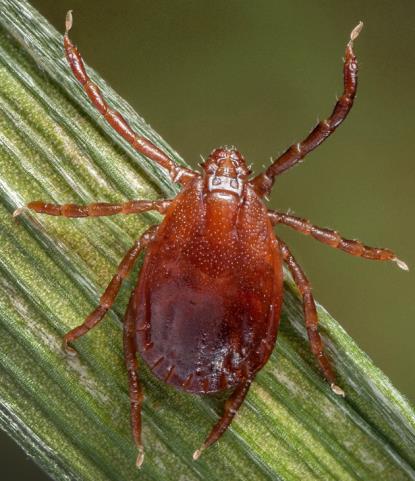The Asian longhorned tick (Haemaphysalis longicornis), also known as the bush tick, is a troublesome parasitic species and is an important vector of disease agents. (Note that vectors are capable of biologically transferring a pathogen from one organism to another.) It also is becoming a problematic invasive species. Specifically, it is invading areas located far from its native region in East and Central Asia and is spreading within the United States. In particular, this arachnid is remarkable because female members can reproduce asexually without mating. Thus, scientists fear that the species will spread rapidly in locations where it has already invaded, thereby transmitting numerous diseases that are potentially harmful to humans and other animals. See also: Acari; Disease; Invasive species; Ixodides; Parasitology; Pathogen; Tick virus diseases; Zoonoses

The Asian longhorned tick had never been detected in the United States prior to 2017. In 2017, though, an Asian longhorned tick was found on a sheep at a farm in New Jersey. Since then, the tick has been detected in eight other states, including Arkansas, Connecticut, Maryland, North Carolina, New York, Pennsylvania, Virginia, and West Virginia. So far, the tick's presence has been confirmed in more than 50 cases by the U.S. Centers for Disease Control and Prevention (CDC). Although most of these cases involved the presence of the Asian longhorned tick on livestock, domestic pets, or wildlife animals, a few reported cases have indicated the presence of ticks directly on humans, as well as the presence of ticks in grassy areas frequented by humans. Fortunately, the ticks collected by the CDC were not found to carry any specific human pathogens. Still, the presence of the ticks raises a strong prospect of harmful disease transmission in the future. See also: Disease ecology
One of the most serious diseases transmitted by the Asian longhorned tick is theileriosis. This disease primarily affects dairy cattle, resulting in large quantities of blood loss and severe reductions in milk production; it also affects sheep, which suffer dramatic reductions in wool output. Other transmitted diseases that affect a variety of animals, including humans, are Lyme disease, anaplasmosis, spotted fever rickettsiosis, Powassan virus, and a number of arboviral encephalitides. One notable emergent viral disease carried by the Asian longhorned tick is severe fever with thrombocytopenia syndrome (SFTS). This infectious disease causes serious hemorrhagic fever and has a relatively high fatality rate of about 12–30% in humans. See also: Anaplasmosis; Arboviral encephalitides; Dairy cattle production; Encephalitis (arboviral); Infectious disease; Lyme disease; Rickettsioses; Sheep
The appearance of the Asian longhorned tick in the United States indicates the growing problem of invasive species in general. As a result of the ease and rapidity of travel by humans and goods, and any vectors that may accompany them, across vast distances, invasive species are finding new locations to inhabit. To prevent the expansion of invasive species, stronger preventative measures must be established to control and eliminate any infected vector populations that can carry a variety of traditional and emerging pathogens. See also: Invasion ecology; Public health





